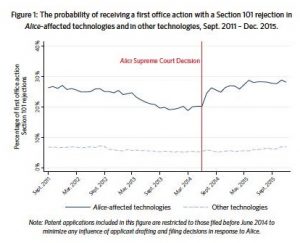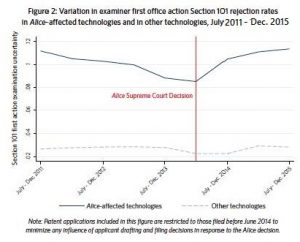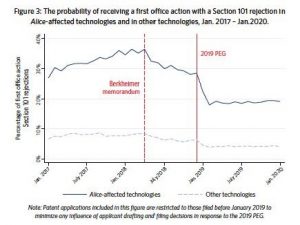USPTO Issues Report by Chief Economist on Statutory Subject Matter Rejections and Impact of the Revised Guidance of January, 2019
It is widely recognized that rejections of applications at the USPTO due to lack of statutory subject matter (35 U.S.C. § 101) increased significantly following the U.S. Supreme Court’s decision in Alice Corp. v. CLS Bank International in June of 2014. In addition to this increase in overall rejections, many of us practicing in this area noticed a wide variability in how different examiners applied the Alice standard. Some were strict to the point of allowing practically nothing in the software and business method fields. Others took a rather mechanical approach, allowing claims if certain structural words were added. Still others would “read out” structural elements from the claims – even physical elements like antennas, transceivers, processors, memories, etc. — and examine only the remaining elements of the claims (thereby improperly dissecting the claims). The variation in approach from examiner to examiner made it extremely difficult to draft and prosecute applications in the arts in any sort of predictable fashion. The situation was improved significantly by issuance of the USPTO’s Revised Patent Subject Matter Eligibility Guidance in January of 2019. While this author still regularly encounters examiners who apparently have not read and therefore do not apply the Revised guidance, among those examiners who do apply the guidance both consistency and reasonableness of §101 rejections has improved.
A new report by the USPTO’s Chief Economist quantifies these impressions, showing that the Revised Guidance has indeed both improved consistency of §101 rejections and reduced §101 rejection overall.
The key findings of the new report are:
- Considering 33 “Alice-affected” technology areas, the report finds that §101 rejections in first office actions increased by 31% in the 18 months following the Alice decision.

2. In the 33 “Alice-affected” technology areas, examination uncertainty (variability from examiner to examiner in making subject matter patentability determinations) increased 26% over the same period.

3. In the one year following issuance of the Revised Guidance (January, 2019 to January, 2020), first office actions including a §101 rejection in the 33 technology areas decreased by 25%.

4. Uncertainty (examiner to examiner variability) in examination of statutory subject matter decreased by 44% over the same one-year period.
The report concludes:
The evidence suggests that the 2019 PEG provided clarity and structure to the decision-making process, thereby reducing the degree of variability observed across examiners in subject matter eligibility determinations. For patent applicants, this finding indicates a more consistent and predictable examination process.
The full report is available here:
https://www.uspto.gov/sites/default/files/documents/OCE-DH_AdjustingtoAlice.pdf




